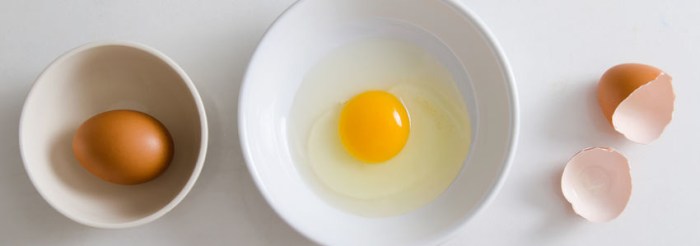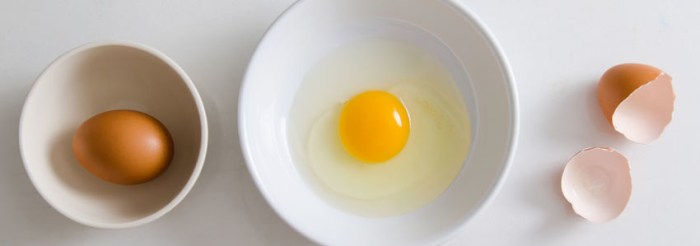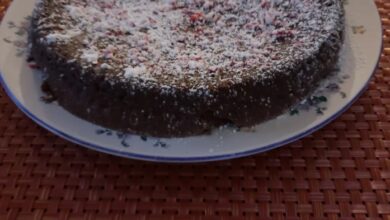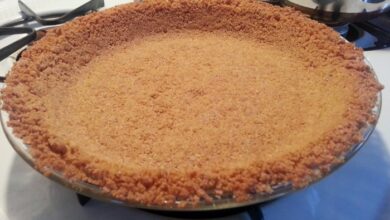
Egg Substitute for Baking: A Guide to Delicious Alternatives
Egg substitute for baking is a lifesaver for those with dietary restrictions, allergies, or simply wanting to explore different baking techniques. Whether you’re vegan, avoiding eggs for health reasons, or just looking for a new way to bake, there are plenty of options available to achieve delicious results.
This comprehensive guide will delve into the world of egg substitutes, exploring various options, their properties, and how they impact your baking. We’ll discuss the role of eggs in baking, common reasons for using substitutes, and provide a detailed comparison of different types, including flaxseed meal, applesauce, mashed banana, and commercial egg replacers.
You’ll also find tips for choosing the right substitute for your recipe and troubleshooting common issues.
Introduction to Egg Substitutes in Baking
Eggs play a crucial role in baking, contributing to the texture, structure, and flavor of many baked goods. They act as binders, leaveners, emulsifiers, and moisture providers, ensuring a successful outcome. However, there are situations where using eggs might be undesirable or impossible, leading to the need for egg substitutes.
Reasons for Using Egg Substitutes
There are several reasons why bakers might choose to use egg substitutes in their recipes. Some common reasons include:
- Dietary restrictions: People with egg allergies or intolerances can use substitutes to enjoy their favorite baked goods without compromising their health.
- Veganism: Vegans avoid all animal products, including eggs, so egg substitutes are essential for creating vegan baked goods.
- Religious beliefs: Some religions have dietary restrictions that prohibit the consumption of eggs, requiring the use of substitutes.
- Cost-effectiveness: Egg substitutes can be more affordable than eggs, especially when baking in large quantities.
- Availability: In some situations, eggs might be scarce or unavailable, making substitutes a practical alternative.
Types of Egg Substitutes, Egg substitute for baking
There are numerous types of egg substitutes available, each with its unique properties and applications. Some popular options include:
- Commercial egg substitutes: These are commercially prepared products designed to mimic the properties of eggs in baking. They typically contain a blend of ingredients like starches, plant proteins, and emulsifiers.
- Flaxseed meal: This ground flaxseed is mixed with water to create a gel-like consistency that can be used as an egg substitute. It’s a good source of fiber and omega-3 fatty acids.
- Applesauce: Applesauce adds moisture and sweetness to baked goods, making it a suitable egg substitute in some recipes. It’s particularly effective in quick breads and muffins.
- Mashed banana: Similar to applesauce, mashed banana provides moisture and sweetness, making it a good substitute for eggs in cakes and cookies.
- Yogurt: Plain yogurt can add moisture and richness to baked goods, making it a suitable egg substitute in some cases. It’s particularly effective in cakes and muffins.
Common Egg Substitute Options: Egg Substitute For Baking
Egg substitutes are essential tools for bakers who need to avoid eggs due to allergies, dietary restrictions, or simply because they don’t have any on hand. While eggs play a crucial role in baking, providing structure, moisture, and richness, these substitutes can effectively mimic their functions.
Sometimes, when I’m baking, I need to use an egg substitute, especially if I’m trying to avoid allergens or just want to experiment. It’s amazing how versatile those substitutes can be! It reminds me of how much I love the versatility of a good stir-fry, like this mongolian beef and spring onions recipe I found.
It’s so simple to make, and the combination of flavors is just perfect. But back to egg substitutes, they’re definitely a must-have in my baking arsenal!
Comparison of Common Egg Substitutes
Various substitutes are available, each with its own unique properties and applications. Understanding their strengths and weaknesses can help you choose the right one for your recipe.
Egg substitutes are a lifesaver for those who avoid eggs or need a vegan option. They work great in cakes and cookies, but for pies, I often find myself reaching for the real deal. Strawberry rhubarb pie is one of those recipes that truly benefits from the richness and texture that eggs bring.
If you’re looking for some delicious inspiration, check out these strawberry rhubarb pie recipes. However, when it comes to egg substitutes, they’re a fantastic option for creating lighter, airy baked goods, so don’t be afraid to experiment!
| Name | Ingredients | Preparation | Typical Usage | Advantages | Disadvantages |
|---|---|---|---|---|---|
| Flaxseed Meal | Ground flaxseeds and water | Mix 1 tablespoon of flaxseed meal with 3 tablespoons of water and let it sit for 5 minutes until it forms a gel. | Cakes, cookies, muffins, and pancakes | Plant-based, good source of fiber, and can be stored for a long time. | May have a slightly nutty flavor that might not be suitable for all recipes. |
| Applesauce | Unsweetened applesauce | Ready to use, no preparation needed. | Cakes, muffins, and quick breads | Adds moisture and sweetness, readily available, and can be stored for a long time. | May make baked goods slightly denser and may not be suitable for recipes that require a light and airy texture. |
| Mashed Banana | Ripe mashed banana | Mash a ripe banana until smooth. | Cakes, muffins, and quick breads | Adds moisture and sweetness, readily available, and can be stored for a long time. | May give baked goods a slightly banana flavor and may not be suitable for recipes that require a neutral flavor. |
| Commercial Egg Replacers | Various ingredients, including potato starch, tapioca starch, and vegetable protein. | Follow the instructions on the package. | Cakes, cookies, muffins, and pancakes | Convenient, often available in various sizes, and can be stored for a long time. | May be more expensive than other substitutes, and some may contain artificial ingredients. |
Flaxseed Meal Egg Substitute Recipe
To prepare a flaxseed meal egg substitute, simply mix 1 tablespoon of ground flaxseed meal with 3 tablespoons of water. Let it sit for 5 minutes until it forms a gel. This mixture can be used as a replacement for one egg in most recipes.
Applesauce Egg Substitute Recipe
Applesauce can be used as a direct egg substitute in many recipes. For each egg required, use 1/4 cup of unsweetened applesauce. Applesauce adds moisture and sweetness, making it a versatile substitute.
Finding the perfect egg substitute for baking can be a bit of a challenge, especially when you’re trying to avoid common allergens. If you’re planning a bake sale, you might want to check out some nut-free bake sale recipes that are sure to be crowd-pleasers.
But don’t worry, there are plenty of egg substitutes that work just as well, like flaxseed meal or applesauce, so you can still create delicious and allergy-friendly treats.
Baking with Egg Substitutes
Baking with egg substitutes can be a successful endeavor, but it requires a bit of understanding and adjustment. While egg substitutes can replicate some of the functions of eggs, they may not always deliver the same results. This section delves into the effects of using egg substitutes on baking outcomes, explores common recipe applications, and presents a simple recipe featuring an egg substitute.
Impact of Egg Substitutes on Baking Outcomes
Egg substitutes can influence various aspects of baking, including texture, volume, and flavor. The impact depends on the type of substitute used and the specific recipe.
Texture
Egg substitutes often affect texture by altering the structure of the baked goods. For example, flaxseed meal, a common egg substitute, can create a slightly denser texture compared to traditional eggs. This is because flaxseed meal absorbs moisture and forms a gel, providing structure.
Volume
Volume can be affected by the ability of the egg substitute to create air pockets during mixing. For instance, applesauce, another popular egg substitute, tends to contribute less volume than eggs due to its lack of protein, which helps to trap air during whipping.
Flavor
Egg substitutes can introduce subtle flavor changes. For example, using a commercially prepared egg substitute may add a slightly “eggy” flavor, whereas alternatives like mashed banana or applesauce can introduce subtle fruit notes.
Recipes Using Egg Substitutes
Egg substitutes are commonly used in various recipes, especially those catering to dietary restrictions or preferences.
- Vegan Baking:Egg substitutes are essential in vegan baking, where animal products are excluded. Recipes like vegan cookies, cakes, and muffins often rely on flaxseed meal, applesauce, or banana as egg replacements.
- Allergy-Friendly Baking:Egg substitutes can be used in recipes for individuals with egg allergies. For instance, a person with an egg allergy could enjoy banana bread or cupcakes made with a substitute like mashed banana or applesauce.
- Health-Conscious Baking:Some egg substitutes, like flaxseed meal or chia seeds, are considered healthier alternatives to traditional eggs, as they are rich in fiber and nutrients.
Simple Cookie Recipe with Egg Substitute
Here’s a recipe for chocolate chip cookies using flaxseed meal as an egg substitute:
Ingredients
- 1 cup (2 sticks) unsalted butter, softened
- 3/4 cup granulated sugar
- 3/4 cup packed light brown sugar
- 1 teaspoon vanilla extract
- 2 1/4 cups all-purpose flour
- 1 teaspoon baking soda
- 1/2 teaspoon salt
- 1 cup semisweet chocolate chips
- Egg Substitute:3 tablespoons ground flaxseed meal + 9 tablespoons water (mixed and allowed to sit for 5 minutes)
Instructions
- Preheat oven to 375°F (190°C). Line a baking sheet with parchment paper.
- In a large bowl, cream together butter and sugars until light and fluffy.
- Beat in vanilla extract.
- In a separate bowl, whisk together flour, baking soda, and salt.
- Gradually add dry ingredients to the wet ingredients, mixing until just combined.
- Stir in chocolate chips.
- Drop by rounded tablespoons onto the prepared baking sheet.
- Bake for 10-12 minutes, or until golden brown.
- Let cool on the baking sheet for a few minutes before transferring to a wire rack to cool completely.
Choosing the Right Egg Substitute

With so many egg substitutes available, choosing the right one for your baking needs can feel overwhelming. But fear not! By considering a few key factors, you can make informed decisions that will ensure your baked goods turn out perfectly.
Factors to Consider
The best egg substitute for you will depend on several factors, including the type of recipe, your dietary restrictions, and your budget.
- Recipe Type:Different egg substitutes excel in different baking applications. For example, flaxseed meal is a great choice for cakes and cookies, while applesauce works well in breads and muffins.
- Dietary Restrictions:If you have allergies or follow a specific diet, you’ll need to choose an egg substitute that aligns with your needs. For example, vegan bakers will need to use plant-based substitutes like flaxseed meal or applesauce.
- Availability:Some egg substitutes, like commercial egg replacers, may be readily available at most grocery stores. Others, like flaxseed meal or applesauce, might require a trip to a specialty store or online retailer.
Suitability of Different Egg Substitutes
Here’s a breakdown of how different egg substitutes perform in various baking applications:
| Egg Substitute | Cakes | Cookies | Bread | Muffins |
|---|---|---|---|---|
| Flaxseed Meal | Good | Good | Fair | Fair |
| Applesauce | Fair | Fair | Good | Good |
| Commercial Egg Replacer | Good | Good | Good | Good |
| Yogurt | Fair | Fair | Good | Good |
Recommendations for Specific Baking Needs
Here are some recommendations for choosing the right egg substitute for different baking needs:
- For cakes and cookies:Flaxseed meal or commercial egg replacer are excellent choices.
- For breads and muffins:Applesauce or yogurt are good options.
- For vegan baking:Flaxseed meal, applesauce, or commercial vegan egg replacers are suitable choices.
Tips for Success with Egg Substitutes
Baking with egg substitutes can be a rewarding experience, allowing you to enjoy delicious treats while accommodating dietary needs or preferences. However, achieving success with egg substitutes requires understanding their unique properties and adapting your baking techniques accordingly. Here are some essential tips to ensure your baked goods turn out perfectly every time.
Understanding the Role of Eggs in Baking
Eggs play a crucial role in baking, contributing to structure, moisture, and richness. They act as binders, holding ingredients together, and as leavening agents, creating air pockets that give baked goods their light and airy texture. Egg substitutes mimic these properties, but they may not always perform identically.
Common Mistakes to Avoid When Using Egg Substitutes
- Using too much or too little egg substitute: Each egg substitute has its own specific ratio, and using the wrong amount can affect the texture and consistency of your baked goods. Always follow the recipe’s instructions carefully.
- Not adjusting the recipe for the specific egg substitute: Different egg substitutes have varying levels of moisture and binding power. Some recipes may require adjustments, such as adding additional liquid or flour, to compensate for the unique properties of the chosen substitute.
- Not preheating the oven properly: Proper preheating is crucial for any baking recipe, but it’s especially important when using egg substitutes. Egg substitutes often require a slightly higher oven temperature to ensure adequate baking time and a well-cooked final product.
- Overmixing the batter: Overmixing can lead to tough, dense baked goods, especially when using egg substitutes. Mixing until just combined is the key to achieving a light and airy texture.
Troubleshooting Common Issues
- Dry or crumbly baked goods: This can be caused by using too little liquid or not enough binding agent. Consider adding a tablespoon or two of milk or water to the batter, or using a more viscous egg substitute.
- Dense or heavy baked goods: This can be due to overmixing or using too much flour. Ensure you mix the batter until just combined and avoid overmixing. If the recipe calls for a specific amount of flour, stick to it, as adding more flour will only make the baked goods denser.
- Flat or deflated baked goods: This could be a result of insufficient leavening or inadequate baking time. Check the recipe’s instructions for the appropriate leavening agent and ensure the baking time is sufficient for the recipe.






